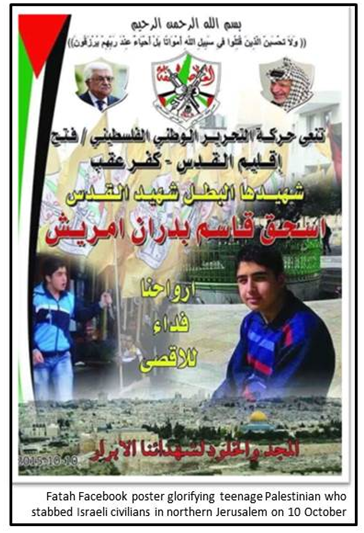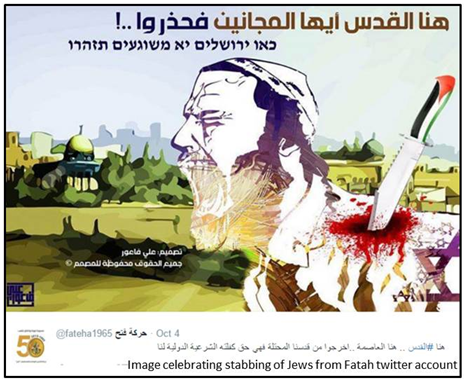Analysis
BICOM Briefing: Background to the current Israeli-Palestinian tensions
Category:
[ssba]
27 October 2015
What has been proposed to restore calm in Jerusalem?
- On Sunday 25 October Israeli Prime Minister Benjamin Netanyahu confirmed he accepted a Jordanian proposal to place 24-hour cameras at the site of Temple Mount/Haram Al-Sharif, saying that it would “disprove the claim that Israel is changing the status quo” and “show where the provocations really come from.” US Secretary of State John Kerry also hailed the proposal as a potential “game-changer.”
- However, Palestinians have criticised the proposal, with senior PLO official Saeb Erekat saying, “Netanyahu wants the video cameras just to track our people and arrest them.”
- Also on Sunday, Jordanian King Abdullah welcomed a statement made by Israeli Prime Minister Benjamin Netanyahu on Saturday night, designed to promote calm. Netanyahu reaffirmed the special Jordanian role at the site; confirmed his commitment to the status quo whereby Muslims pray and non-Muslims only visit the site; welcomed increased coordination between Israel and the Jordanian Waqf (Islamic religious) authorities; and backed a call to end all provocations.
- As a concrete measure to improve the atmosphere, Israel in recent days dropped restrictions on Muslim men below a certain age visiting, which had been put in place to stop disturbances. This follows a decision by Netanyahu two weeks ago to avoid provocations by stopping all Knesset members, Jewish or Arab, from visiting the site.
What is the context to the tension around the Temple Mount/Haram al-Sharif?
- The Temple Mount/Haram al-Sharif is an area of 150,000 square meters (37 acres) located on the eastern edge of the Old City in Jerusalem, which is of great religious significance for Jews, Muslims and Christians. For Jews, Jerusalem is their ancient political and religious centre going back 3000 years, and their modern capital. It is also the most important city for Palestinians, containing Islam’s third holiest Mosque, and where they would like to locate their future capital.
Significance for Jews
- The ‘Temple Mount’ (Har Habayit) is the holiest site in the world for Jews, being the location of the First and Second Jewish Temples (the Second destroyed by the Romans in 70 CE). The mount was enlarged to its current size by King Herod (73 to 4 BCE).
- Since the destruction of the Second Temple, traditional Rabbinic rulings prohibit Jews from ascending to the Temple Mount itself, for fear of desecrating or trespassing on sacred ground. Whilst Orthodox Jews pray for the restoration of the Temple, mainstream Jewish law prohibits attempts to build the Temple before the coming of the Messiah. Since the destruction of the Temple, Jews worship instead at the foot of an external retaining wall of the Mount itself (the Western Wall or ‘Kotel’). This is immediately adjacent to and below the Al Aqsa Mosque.
- In recent decades some national religious Rabbis and movements have challenged the traditional view, and called for Jews to visit and pray on the Temple Mount, claiming the right of equal access for all religions. Whilst these movements have supporters on the right wing of the Israeli government, Israeli government policy stands behind the status quo.
Significance for Muslims
- Muslims conquered Jerusalem in the 7th Century, and built the Al Aqsa Mosque on the Temple Mount, known to Muslims as Al-Haram al-Sharif (The Nobel Sanctuary). The distinctive golden Dome of the Rock is a separate structure built by Muslims over the ‘foundation stone’. This stone marks where the ‘Holy of Holies’ or inner sanctuary of the Jewish temples was located, and is associated with many traditions in both Islam and Judaism.
- When Mohammed first began his ministry he instructed his followers to pray in the direction of Jerusalem (as Jews do), only later in his ministry changing the direction of prayer to Mecca. The Al Aqsa Mosque is the third holiest mosque in the Islamic world, after the mosques in Mecca and Medina (Saudi Arabia).
- Jerusalem (known to Muslims as Al Quds) is not mentioned in the Quran, though Islamic tradition associates Al-Haram al-Sharif as the destination of the night journey Mohammed made on a winged horse before ascending to heaven.
The Status Quo
- From the end of the British Mandate in 1948 until 1967 Jerusalem was divided between Israeli and Jordanian control, with the Old City on the Jordanian side with no Jewish access to the Western Wall.
- After Israel captured the Old City and East Jerusalem in the 1967 Six Day War, for the first time in 19 years Jews were able to pray at the Western Wall. However, Israel allowed Jordanian Islamic religious authorities (‘Waqf’) to remain in charge of the Temple Mount/Haram al-Sharif, paid by the Jordanian government. Sticking to long-standing conventions, Israel maintained the status quo whereby non-Muslims can visit the site, but are banned from prayer, even though this arrangement challenges the notion of Israeli sovereignty over Judaism’s holiest site, and the notion of freedom of religion.
- Despite constant attempts from religious and political activists on all sides to assert greater control over the holy sites, Israeli governments have shown great consistency in leaving administration of the site in the hands of the Waqf. When Israel signed a peace treaty with Jordan in 1994 it formally recognised the special role of Jordan in Muslim Holy shrines in Jerusalem. Netanyahu has said unequivocally that the Israeli government will not change the status quo, and reprimanded ministers on the right of the coalition who have called for changes.
- Israeli security services foiled a plot by Jewish extremists to destroy the Islamic buildings in 1984.
- During the Second Intifada, between 2000 and 2003, no Jews or tourists were allowed onto the compound because of the tense situation. Since 2003, Israeli authorities have permitted Jews and tourists to ascend to the Temple Mount for several hours each day. The times are coordinated with the Waqf so as not to interfere with Muslim prayers. Visitors are accompanied by Israeli police, who seek to prevent friction and prevent Jews from conducting prayer.
- Each side accuses extremists on the other side of trying to challenge the status quo. Palestinians point to Jewish extremists who demand payer rights and in some cases attempt to carry out prayer. Israelis point to Islamic extremists such as the Northern branch of the Islamic Movement in Israel, which organises and pays activists to intimidate and sometimes assault non-Muslims visiting the site, as well as spreading incitement.
What is the cause of the recent disturbances?
- Though ‘lone wolf’ Palestinian terror attacks and violent demonstrations have come in increasing waves over recent years, the current escalation began during the Jewish holiday period in September 2015. The holiday period brought an increase in Jewish visitors to the Temple Mount/Haram al-Sharif. Palestinian youths in East Jerusalem were spurred by accusations that Israel intends to take over some or part of the Temple Mount/Haram al-Sharif. Such charges have frequently been repeated by Palestinian agitators over many years, and they were unequivocally rejected by Prime Minister Netanyahu.
- Israeli officials blame both the Palestinian Authority led by Mahmoud Abbas, and Hamas and Islamist groups inside Israel for inflaming the situation through incitement, including promoting the false charge that Israel intends to change the status quo.
- Extremists on both sides have contributed to the hiking of tensions. The radical northern branch of the Islamic Movement inside Israel, led by Raed Salah, has paid Muslim activists, known as Mourabitounto harass and sometimes assault Jewish visitors to the Temple Mount. During the Jewish holiday period, Palestinian youths repeatedly brought stones, firecrackers and in some cases small pipe bombs into the compound and barricaded themselves in the Al Aqsa Mosque with the intention of provoking disturbances and preventing non-Muslims visiting the area. Israeli riot police then ascended the Temple Mount/Haram al-Sharif to disarm them, leading to clashes. (For video footage click here.)
- Meanwhile tensions and suspicions have been heightened by extreme Jewish nationalist groups and politicians who – against the government’s position – seek to challenge the status quo arrangements which tightly restrict Jewish access and ban Jewish prayer on the site. In some cases individual ministries have channelled money to Israeli NGOs whose activities include advocating for changes to the status quo. For example, a 2013 investigation by Israeli Army Radio found that in 2012 the ‘Temple Institute’ received NIS 282,000 (£47,500) from the Education Ministry and another NIS 134,000 (£22,500) from the Culture Ministry, which the ministries claimed were intended to support research and educational activities.
What is the nature and scale of the violence?
- From 1-26 October 2015 there were 47 stabbings, 4 shootings and 5 car rammings perpetrated by Palestinians against Israelis, with 11 Israelis killed and 126 wounded, 13 seriously. Whilst the initial concentration of attacks was in and around Jerusalem, with Arab youth from East Jerusalem the main perpetrators, the attacks subsequently spread to other Israeli cities and the West Bank.
- Between October 1 and 19, according to a UN source, 43 Palestinians were killed, mostly in the act of carrying out an attack on Israelis or in violent demonstrations confronting Israeli security forces in the West Bank of the Israel-Gaza border.
- Most Palestinian knife attacks are carried out by young individuals (typically teens or early 20s) unaffiliated to a specific organisation, with social media appearing to play a role in their radicalisation. A small number of Palestinian attacks, particularly those using firearms, have been attributed to organised Hamas cells.
Why does Israel say Palestinian incitement is to blame?
- Antisemitic and anti-Israel rhetoric, images and slogans are rife in Palestinian society, media and education systems, and on social media like Facebook and Twitter, which Palestinians use widely.
- Israeli leaders have long accused Palestinian leaders of all factions of actively fuelling incitement. Whilst Palestinian President Mahmoud Abbas does not openly call for armed attacks, he and his Fatah movement glorify terrorists and attacks on Jews. Fatah adopted in its 2009 conference a call for ‘popular resistance’, an ambiguous term which encompasses both demonstrations and violent actions using ‘cold weapons’ like knives and stones.
- Abbas has personally engaged in incendiary rhetoric and claims:
- In recent years Abbas has repeated the accusation that Israel intends to harm the Al Aqsa Mosque, though there is no basis to this.
- In 2014 he sent a letter to the family of an Islamic Jihad gunman praising him as a martyr, after he was tracked down and killed in a shootout following his attempt to assassinate Jewish Temple Mount activist Yehuda Glick.
- In a televised speech on 16 September 2015 Mahmoud Abbas said: “The Al-Aqsa [Mosque] is ours … and they [Jews] have no right to defile it with their filthy feet. We will not allow them to, and we will do everything in our power to protect Jerusalem.”
- In a speech on 15 October, Abbas accused Israel of executing in cold blood 13-year-old Ahmed Manasra. In fact Mansara and his 15-year-old cousin had stabbed two people in Jerusalem, and Mansara was alive and receiving treatment in an Israeli hospital.
- Meanwhile Hamas is actively calling for and seeking to ferment a third Intifada which would harm both Israel and their rivals in the Palestinian Authority.
- The bloody nature of the images and prominence of knives in propaganda on Palestinian social media may attest to the indirect influence of Islamic State propaganda. Islamic State has sent messages in support of the Palestinian violence.
Examples of Fatah incitement

